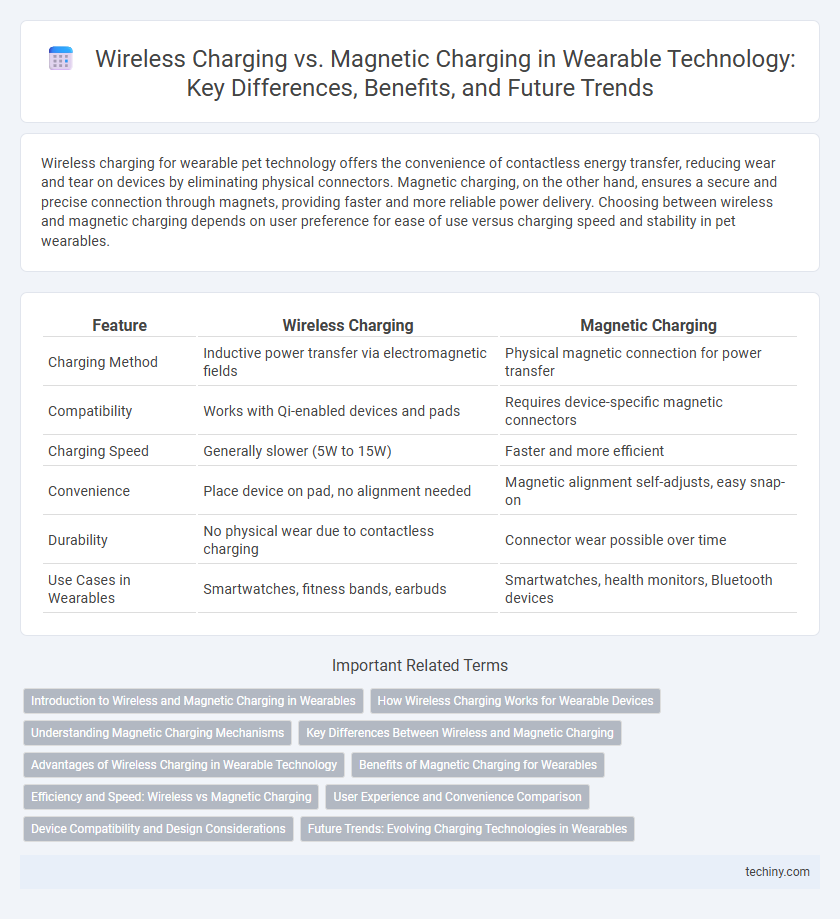Wireless charging for wearable pet technology offers the convenience of contactless energy transfer, reducing wear and tear on devices by eliminating physical connectors. Magnetic charging, on the other hand, ensures a secure and precise connection through magnets, providing faster and more reliable power delivery. Choosing between wireless and magnetic charging depends on user preference for ease of use versus charging speed and stability in pet wearables.
Table of Comparison
| Feature | Wireless Charging | Magnetic Charging |
|---|---|---|
| Charging Method | Inductive power transfer via electromagnetic fields | Physical magnetic connection for power transfer |
| Compatibility | Works with Qi-enabled devices and pads | Requires device-specific magnetic connectors |
| Charging Speed | Generally slower (5W to 15W) | Faster and more efficient |
| Convenience | Place device on pad, no alignment needed | Magnetic alignment self-adjusts, easy snap-on |
| Durability | No physical wear due to contactless charging | Connector wear possible over time |
| Use Cases in Wearables | Smartwatches, fitness bands, earbuds | Smartwatches, health monitors, Bluetooth devices |
Introduction to Wireless and Magnetic Charging in Wearables
Wireless charging in wearables uses electromagnetic fields to transfer energy between a charging pad and the device without physical connectors, enhancing user convenience and reducing wear on ports. Magnetic charging employs magnetic pins or connectors that align automatically, ensuring efficient power transfer and rapid charging times while maintaining device water resistance. Both technologies aim to improve charging speed, durability, and user experience in compact wearable devices like smartwatches and fitness trackers.
How Wireless Charging Works for Wearable Devices
Wireless charging for wearable devices utilizes electromagnetic fields to transfer energy between a charging pad and the device via inductive coupling. This process involves a coil in the charger generating an alternating magnetic field that induces a current in a corresponding coil within the wearable device, enabling power transfer without physical connectors. Efficiency depends on coil alignment, frequency, and distance, with advancements improving charging speed and convenience for compact, low-power wearables.
Understanding Magnetic Charging Mechanisms
Magnetic charging mechanisms in wearable technology utilize electromagnetic induction to transfer energy wirelessly through a magnetic field, enabling efficient power delivery without physical connectors. This technology relies on coils within both the charger and the device that align magnetically for optimal energy transfer, reducing wear and tear compared to traditional wired methods. Understanding the principles of resonant inductive coupling is crucial for improving charging speeds and device compatibility in magnetic wireless charging systems.
Key Differences Between Wireless and Magnetic Charging
Wireless charging uses electromagnetic fields to transfer energy over short distances without direct contact, whereas magnetic charging requires physical alignment and connection between magnets on the charger and device. Wireless charging offers more convenience and flexibility by enabling charging on compatible surfaces, while magnetic charging provides faster, more stable energy transfer with precise docking. Battery health optimization varies as wireless charging typically generates more heat compared to magnetic charging, potentially affecting long-term device performance.
Advantages of Wireless Charging in Wearable Technology
Wireless charging in wearable technology offers the advantage of enhanced convenience by eliminating the need for physical connectors, reducing wear and tear on devices. It supports continuous power delivery during everyday activities, promoting longer usage without interruptions. Advanced wireless charging standards also enable faster and more efficient energy transfer, improving overall device performance and user experience.
Benefits of Magnetic Charging for Wearables
Magnetic charging offers a secure and stable connection for wearable devices, minimizing the risk of disconnection during use and ensuring consistent power transfer. This method reduces wear and tear on charging ports, enhancing device longevity and user convenience. Furthermore, magnetic charging supports faster alignment and efficient energy transfer, improving the overall charging experience for smartwatches, fitness trackers, and other wearables.
Efficiency and Speed: Wireless vs Magnetic Charging
Wireless charging offers moderate efficiency with energy losses often around 20-30%, leading to slower charging speeds compared to magnetic charging. Magnetic charging utilizes precise alignment through magnetic connectors, resulting in higher energy transfer efficiency and faster charging times for wearable devices. Efficiency in magnetic charging typically reaches over 85%, significantly outperforming standard wireless charging in both speed and power conservation.
User Experience and Convenience Comparison
Wireless charging enables seamless power replenishment for wearable technology without the need for cables, enhancing user convenience through simple placement on charging pads and reducing wear on charging ports. Magnetic charging provides a secure, precise connection using magnets that align the device effortlessly, minimizing misplacement and interruptions during charging sessions. Both methods improve portability and ease of use, but magnetic charging typically offers faster alignment and durability benefits critical for active wearables.
Device Compatibility and Design Considerations
Wireless charging offers broader device compatibility with most modern wearables supporting Qi or similar standards, while magnetic charging often requires proprietary connectors tailored to specific models for secure attachment. Design considerations for wireless charging emphasize sleekness and convenience without exposed contacts, enhancing water resistance and aesthetics. Magnetic charging designs focus on precise alignment and durability of the connection points, potentially limiting freedom of placement but providing faster and more reliable power transfer for compatible devices.
Future Trends: Evolving Charging Technologies in Wearables
Wireless charging in wearable technology is advancing with innovations like resonant inductive coupling enabling greater distance and efficiency compared to traditional magnetic charging pads. Emerging trends emphasize integration of flexible, lightweight materials and ultra-fast charging capabilities that support continuous usage without bulky chargers. Future developments foresee seamless energy harvesting and bidirectional wireless power transfer, enhancing user convenience and device autonomy in wearables.
Wireless Charging vs Magnetic Charging Infographic

 techiny.com
techiny.com